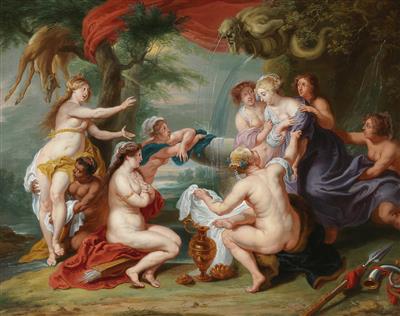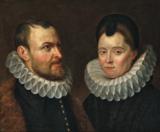Workshop of Peter Paul Rubens

(Siegen 1577–1640 Antwerp)
Diana discovering Callisto’s pregnancy,
oil on copper, 60 x 75 cm, framed
Provenance:
Private European collection;
sale, Dorotheum, Vienna, 13 October 2010, lot 397;
Private European collection
This scene, which was probably commissioned by a private collector, is a workshop variant of a painting by Rubens executed in 1636–38 for King Philip IV of Spain (now in the Museo del Prado, Madrid). Since the first version did not leave the workshop before 1638, the present painting could have been created as a smaller variant during these two years. The first version formed part of a series of sixty large paintings for the royal hunting lodge, the Torre de la Parada. The scene shows the moment when Diana discovers the pregnancy of her nymph Callisto. This subject was frequently treated during the Baroque and is based on Ovid’s Metamorphoses. Rubens had already dealt with the theme in 1596, when he made a copy after Titian for Philip II of Spain.
At present it has not been possible to identify all of the workshop members working for Rubens at the time. Among the artists involved in the Torre de la Parada cycle were Frans Snijders and Paul de Vos; the latter’s hand is also recognisable in some of the details in the Prado’s Callisto. It was certainly not possible for Rubens to complete as many as sixty large paintings during the short term of two years allowed by the contractual terms. For this reason, the author of the present painting must have been a workshop collaborator and the painting can only have been made between 1636 and 1638, as the cycle was no longer accessible afterwards.
The present painting was probably executed with the participation of Willem van Herp, who first appears in the books of the Antwerp guild of St. Luke in 1637, at the time of the Torre de la Parada commission. It has so far neither been possible to prove his collaboration in Rubens’s workshop, nor to exclude it. However, the present painting could be regarded as evidence for Herp’s presence in Rubens’s workshop around 1637. The rich colours of the present painting convey the impression of the original state of the Prado version.
Specialist: Dr. Alexander Strasoldo
 Dr. Alexander Strasoldo
Dr. Alexander Strasoldo
+43-1-515 60-556
alexander.strasoldo@dorotheum.at
23.10.2018 - 18:00
- Realized price: **
-
EUR 25,000.-
- Estimate:
-
EUR 20,000.- to EUR 30,000.-
Workshop of Peter Paul Rubens
(Siegen 1577–1640 Antwerp)
Diana discovering Callisto’s pregnancy,
oil on copper, 60 x 75 cm, framed
Provenance:
Private European collection;
sale, Dorotheum, Vienna, 13 October 2010, lot 397;
Private European collection
This scene, which was probably commissioned by a private collector, is a workshop variant of a painting by Rubens executed in 1636–38 for King Philip IV of Spain (now in the Museo del Prado, Madrid). Since the first version did not leave the workshop before 1638, the present painting could have been created as a smaller variant during these two years. The first version formed part of a series of sixty large paintings for the royal hunting lodge, the Torre de la Parada. The scene shows the moment when Diana discovers the pregnancy of her nymph Callisto. This subject was frequently treated during the Baroque and is based on Ovid’s Metamorphoses. Rubens had already dealt with the theme in 1596, when he made a copy after Titian for Philip II of Spain.
At present it has not been possible to identify all of the workshop members working for Rubens at the time. Among the artists involved in the Torre de la Parada cycle were Frans Snijders and Paul de Vos; the latter’s hand is also recognisable in some of the details in the Prado’s Callisto. It was certainly not possible for Rubens to complete as many as sixty large paintings during the short term of two years allowed by the contractual terms. For this reason, the author of the present painting must have been a workshop collaborator and the painting can only have been made between 1636 and 1638, as the cycle was no longer accessible afterwards.
The present painting was probably executed with the participation of Willem van Herp, who first appears in the books of the Antwerp guild of St. Luke in 1637, at the time of the Torre de la Parada commission. It has so far neither been possible to prove his collaboration in Rubens’s workshop, nor to exclude it. However, the present painting could be regarded as evidence for Herp’s presence in Rubens’s workshop around 1637. The rich colours of the present painting convey the impression of the original state of the Prado version.
Specialist: Dr. Alexander Strasoldo
 Dr. Alexander Strasoldo
Dr. Alexander Strasoldo
+43-1-515 60-556
alexander.strasoldo@dorotheum.at
|
Buyers hotline
Mon.-Fri.: 10.00am - 5.00pm
old.masters@dorotheum.at +43 1 515 60 403 |
| Auction: | Old Master Paintings |
| Auction type: | Saleroom auction |
| Date: | 23.10.2018 - 18:00 |
| Location: | Vienna | Palais Dorotheum |
| Exhibition: | 13.10. - 23.10.2018 |
** Purchase price incl. charges and taxes
It is not possible to turn in online buying orders anymore. The auction is in preparation or has been executed already.
More objects by this artist
-

Estimate:
EUR 10,000.- to EUR 15,000.-
